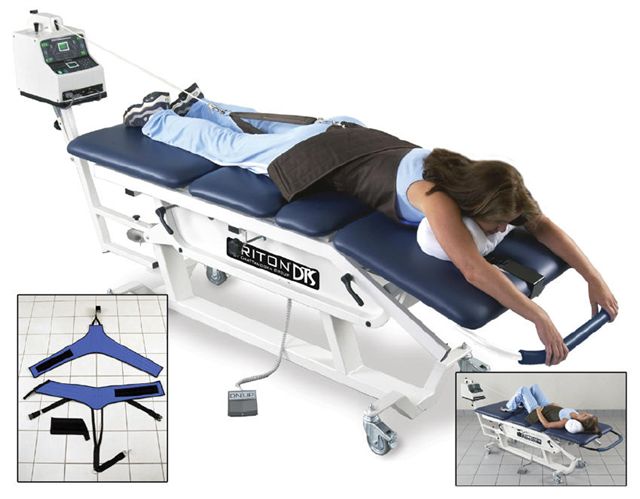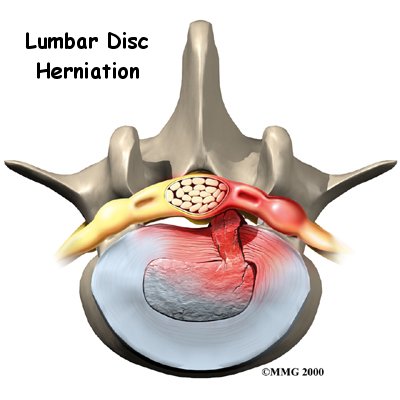VAIL CHIROPRACTIC IS THE FIRST AND ONLY CHIROPRACTIC AND HEALTHCARE OFFICE IN THE AREA THAT OFFERS SPINAL DECOMPRESSION THERAPY.

SPINAL DECOMPRESSION THERAPY (AKA. Traction)
This breakthrough technology brings new hope to those suffering from disabling spinal conditions such as disc herniations, disc degeneration, sciatica, and facet syndrome.
Spinal Decompression Therapy is performed on a specially designed table in either a face up or face down position. Clinical consideration and your comfort are used in deciding which position will be best for you. You will remain fully dressed during the treatment. You will be comfortably position on the table and fitted with a wrap around belt. This restraint is what allows the unloading of the spine and discs by the traction motor. Your position on the table, the harness and angle of distraction allows for accurate and focused treatment of the affected disc and area.
Once comfortable on the DTS the computer controlled traction devise is programmed to deliver a gentle stretching force to the spinal vertebra. The DTS system applies the gentle force then releases it approximately every minute throughout the session. Total treatment time is less than 18 minutes. Most patients report simple feeling a subtle and gentle stretching at their lower backs and hips. Since DTS therapy is a comfort-base procedure, patients usually report a sense of relief and relaxation during the session.
IMBIBING THE DISCS
The gentle stretching and relaxing of the spine fosters a phenomenon called “imbibition”. This is the way the disc gets nutrition. This pumping action promotes nutrition intake into the discs, something often lost in damaged and degenerative disc conditions. In healthy discs, imbibition occurs naturally with daily motions and body positions. A disc with poor imbibition, fewer nutrients and hydration, is more likely to become injured and painful.
Stretching or tractioning the spine in a controlled and comfortable manner can help re-establish a more normal imbibition. This can re-supply the disc with nutrients and blood contact that help the disc heal from the inside out. Also the dramatic decrease of pressure in the disc (decompression) can foster the drawing in of a bulge and help take pressure off a “pinched” spinal nerve.

DTS THERAPY FAQS
Though each patient is different and no doctor can guarantee success, the clinical result of this type of therapy has been effective in over 75% of patients treated. The common problems to many back conditions are damaged discs and poor spinal muscle control. Our treatment programs address both of these core problems. The DTS System creates a controlled unloading of the vertebra to decrease disc pressure thus increasing blood and nutrient exchange. This exchange of fluids is something the damaged disc desperately needs to help it heal from inside out. Muscle strength, control and endurance can all be improved with other facet of DTS Therapy that include specific controlled exercises.
Although it is difficult to predict the future, our experience is that most patients do find long-term relief or effective management of their pain when they complete the entire program of treatments. Regular home exercise and periodic visits to our clinic will help in maintaining your spinal health and reduce the probability of reoccurrence. As with any comprehensive rehabilitation program your continued home care exercises and discretion in some daily activities is key to long-term relief.
DTS Therapy treatments are one of most gentle and comfortable therapies available. The treatments utilize equipment with proven safety and efficacy. Most patients report a mild sense of stretch on their back or hips, and often fall asleep during treatment sessions. The DTS System is produced by the world’s largest manufacturer of hospital base rehabilitation equipment, with over 58 years of experience.
All though traction therapy has been around for thousands of years, Decompression Traction is relatively new. Advances in equipment and procedures have dramatically improved effectiveness. DTS Therapy is the most comprehensive program available, allowing the safe delivery of this previously hospital based therapy in our office. Continual improvement in the delivery system and regular updates in protocol keep the DTS in the forefront on non-invasive disc therapy. Each year over 50,000 patients are treated with DTS Therapy and that number is growing.
DTS Therapy is a comprehensive program of the newest traction techniques and targeted “core” stabilization exercise with Biofeedback. In addition we use other adjunctive treatments that have proven effectiveness in back care. It is this multi-faceted approach that makes the overall treatment so effective. Additionally, discs have been shown to be a predominate site of pain, so treating it as directly as possible makes sense. The blending of focused traction to the site, rehabilitation to the supporting structures, and overall strengthening of global musculature makes the treatment unique. DTS Therapy affects the disc as directly as possible without surgery.
Along wit the damage in the disc we also need to treat the supporting spinal muscles. A complete program targeting the function of the stabilization muscles is a vital part of DTS Therapy. Heat, muscle stimulation, and ice can offer an additional benefit for inflammation and spasm reduction. Our hope is not only to help heal the disc but enhance muscle control and support of the low back. A gradual breakdown of the foundational support of you back is what puts undue stresses on the discs and leads to pain and loss of function. Exercise and adjunctive therapies will assist in rehabilitating these structures.
It depends on the complexity and extent of the rehabilitation needed, however we typically treat 3 times a week for 1 month, transitioning from passive to active treatments as you respond. The treatment is administered over a reasonable time frame and your response is continually evaluated. Further treatments may be necessary oar a reduced frequency may be recommended at that time. The rehabilitative phase may include additional DTS Therapy treatments, with spinal adjustments to enhance to the results. Most patients are released from treatment after 8 weeks.
Our office visits vary as the extent of care needed, (DTS Therapy, adjustments, muscle stimulation, etc.) However we promise to only do those procedures necessary for your fullest recovery. You always have to choice as to the extent of care. Our staff will review all costs, payment options and insurance coverage up front. We want to help, and believe finances shouldn’t stand in the way of you and good health.